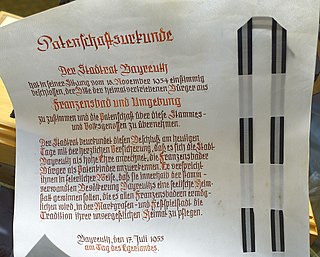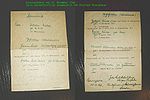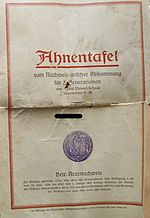
The master race is a pseudoscientific concept in Nazi ideology in which the putative "Aryan race" is deemed the pinnacle of human racial hierarchy. Members were referred to as "Herrenmenschen".
Mischling was a pejorative legal term used in Nazi Germany to denote persons of mixed "Aryan" and non-Aryan, such as Jewish, ancestry as codified in the Nuremberg racial laws of 1935. In German, the word has the general denotation of hybrid, mongrel, or half-breed. Outside its use in official Nazi terminology, the term Mischlingskinder was later used to refer to war babies born to non-white soldiers and German mothers in the aftermath of World War II.

Alexander Mitscherlich was a German psychoanalyst.
A German Blood Certificate was a document provided by Nazi leader Adolf Hitler to Mischlinge, declaring them deutschblütig. This practice was begun sometime after the Nuremberg Laws of 1935, and allowed exemption from most of Germany's racial laws.

Curt Bois was a German actor with a career spanning over 80 years. He is best remembered for his performances as the pickpocket in Casablanca (1942) and the poet Homer in Wings of Desire (1987).
Hermann Baumann was an influential German Africa expert.

The Ahnenpaß documented the Aryan lineage of people "of German blood" in Nazi Germany. It was one of the forms of the Aryan certificate (Ariernachweis) and issued by the "Reich Association of Marriage Registrars in Germany".
East Upper Silesia is the easternmost extremity of Silesia, the eastern part of the Upper Silesian region around the city of Katowice. The term is used primarily to denote those areas that became part of the Second Polish Republic on 20 June 1922, as a consequence of the post-World War I Treaty of Versailles. Prior to World War II, the Second Polish Republic administered the area as Autonomous Silesian Voivodeship. East Upper Silesia was also known as Polish (Upper) Silesia, and the German (Upper) Silesia was known as West Upper Silesia.
Karl Ritter was a German diplomat during the Third Reich and was convicted as a war criminal in the Ministries Trial. A member of the Nazi Party, he was ambassador to Brazil for two years, Special Envoy to the Munich Agreement, and a senior official in the Foreign Office during World War II.

Albert Merz was a German Christadelphian who was executed for refusing to bear arms in the Second World War.

"Nun freut euch, lieben Christen g'mein", or “Dear Christians, One and All, Rejoice” in English, is a Lutheran hymn, written in 1523 by Martin Luther. It is one of Luther's early hymns and considered by some as one of his finest. It was published as one of eight songs in 1524 in the first Lutheran hymnal, the Achtliederbuch. The Achtliederbuch contained four songs by Luther, three by Speratus, and one by Justus Jonas. It appeared also in 1524 in the Erfurt Enchiridion.

Gerhard Zwerenz was a German writer and politician. From 1994 until 1998 he was a member of the Bundestag for the Party of Democratic Socialism (PDS).
The "Einheitsfrontlied" is one of the most famous songs of the German labour movement. It was written by Bertolt Brecht and composed by Hanns Eisler. The best-known rendition was sung by Ernst Busch.
Sybille Steinbacher is a German historian. Since May 2017 she has been Professor of Holocaust Studies at Goethe University Frankfurt.

Volksgenosse is a German language term meaning a fellow member of a community or compatriot. The word was recorded as early as 1798 and its usage grew within the Völkisch movement of German ethnic nationalism, which led to its use to denote a person of the same "blood community". The term became common parlance within the Nazi Party, then the Third Reich, as a way to distinguish ethnic Germans from other groups, such as Jews and Gypsies. Due to these associations, the word gradually fell out of use after Germany's defeat in World War II and subsequent denazification efforts.
Norbert Frei is a German historian. He holds the Chair of Modern and Contemporary History at the University of Jena, Germany, and leads the Jena Center of 20th Century History. Frei's research work investigates how German society came to terms with Nazism and the Third Reich in the aftermath of World War II.
Michael Maaser is a German historian, archivist of the Goethe University Frankfurt.
Karin Orth is a German historian, known for her research into the Nazi concentration camps.
Wir sind des Geyers schwarzer Haufen is an interwar-era German marching song. Composed around the 1920s, the lyrics of the song are sourced from the poem Ich bin der arme Konrad by the Bavarian poet and artillery officer Heinrich von Reder. The melody of the song is arranged by German songwriter and Nazi Fritz Sotke. As a song about the German Peasants' War, the song lyrics are noted for their strong anti-clerical and anti-noble themes.

A Man and His Dog is a 1918 narrative by Thomas Mann. It describes the adventures of the narrator with his dog Bauschan (Bashan) in the nature surrounding the author's home in Munich. It was written in the twilight of World War I and portrays an idealised and timeless world.












